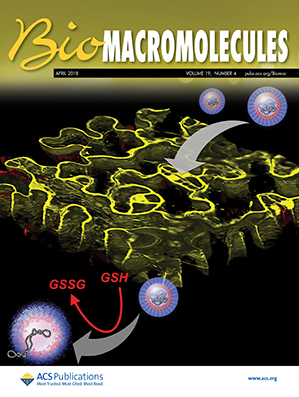Programmable Fabrics of Enzyme-Responsive Amphiphiles: A Multiscale Platform for Hierarchical Mesophase Transformations
IF 5.5
2区 化学
Q1 BIOCHEMISTRY & MOLECULAR BIOLOGY
引用次数: 0
Abstract
Systems capable of undergoing a controlled cascade of mesophase transitions across hierarchical scales represent a novel class of dynamic materials. Here, we describe an electrospun polymeric fabric composed of enzyme-responsive di- and triblock copolymers that undergoes a hierarchical cascade of four distinct mesophases. Initially, on immersion in water, the macroscale fabric dissolves, forming nanoscale micelles. Enzymatic degradation of the diblock components triggers a transition into a triblock-based hydrogel. Finally, the enzymatic degradation of the hydrogel into hydrophilic polymers leads to complete dissolution. By adjusting the di- and triblock ratios, we can finely tune the fabric’s dissolution rate. Moreover, the fibers can encapsulate hydrophobic agents, which are retained within the micelle and hydrogel phases, enabling their controlled release. This cascade of mesophase transitions, from a macroscopic solid to nanoscale assemblies, organized hydrogels, and eventual molecular dissolution, demonstrates sophisticated hierarchical control, unlocking new opportunities for biomedical applications of programmable materials.
- Download: Download high-res image (84KB)
- Download: Download full-size image
酶反应性两亲植物的可编程结构:分层中间相转化的多尺度平台。
系统能够经历一个控制级联的中间相转变跨越层次尺度代表一类新的动态材料。在这里,我们描述了一种由酶反应二嵌段共聚物和三嵌段共聚物组成的电纺丝聚合物织物,它经历了四个不同中间相的分层级联。最初,浸泡在水中,宏观尺度的织物溶解,形成纳米尺度的胶束。酶降解双块组分触发过渡到基于三块的水凝胶。最后,酶降解水凝胶成亲水性聚合物导致完全溶解。通过调节二嵌段和三嵌段的比例,我们可以很好地调节织物的溶解速率。此外,纤维可以包封疏水剂,这些疏水剂保留在胶束和水凝胶相中,使其能够控制释放。从宏观固体到纳米级组件、有组织的水凝胶以及最终的分子溶解,这种中间相转变的级联,展示了复杂的层次控制,为可编程材料的生物医学应用打开了新的机会。
本文章由计算机程序翻译,如有差异,请以英文原文为准。
求助全文
约1分钟内获得全文
求助全文
来源期刊

Biomacromolecules
化学-高分子科学
CiteScore
10.60
自引率
4.80%
发文量
417
审稿时长
1.6 months
期刊介绍:
Biomacromolecules is a leading forum for the dissemination of cutting-edge research at the interface of polymer science and biology. Submissions to Biomacromolecules should contain strong elements of innovation in terms of macromolecular design, synthesis and characterization, or in the application of polymer materials to biology and medicine.
Topics covered by Biomacromolecules include, but are not exclusively limited to: sustainable polymers, polymers based on natural and renewable resources, degradable polymers, polymer conjugates, polymeric drugs, polymers in biocatalysis, biomacromolecular assembly, biomimetic polymers, polymer-biomineral hybrids, biomimetic-polymer processing, polymer recycling, bioactive polymer surfaces, original polymer design for biomedical applications such as immunotherapy, drug delivery, gene delivery, antimicrobial applications, diagnostic imaging and biosensing, polymers in tissue engineering and regenerative medicine, polymeric scaffolds and hydrogels for cell culture and delivery.
 求助内容:
求助内容: 应助结果提醒方式:
应助结果提醒方式:


